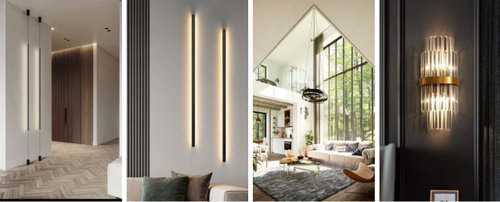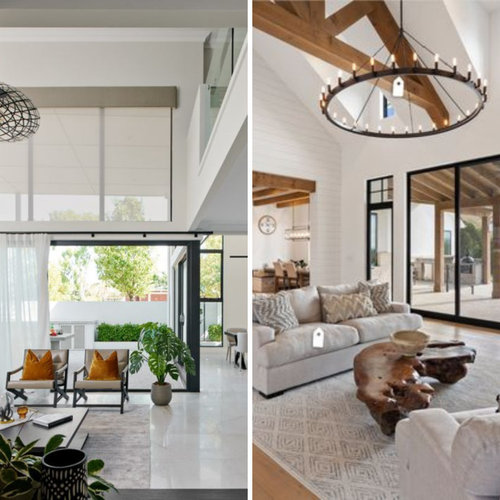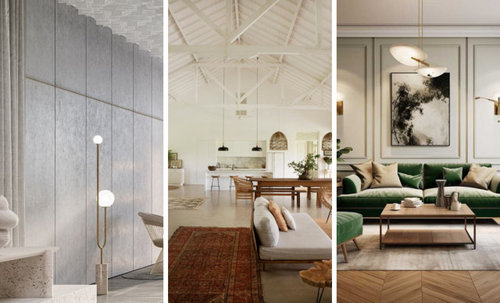How to design a home with high ceilings
High ceilings aren't just an architectural feature, they're a key element to various interior design styles. From urban living and mid-century traditions to statement contemporary homes. When it comes to using high ceilings in your interior design, the sky's the limit for creativity! So, in this blog, we’ll be exploring the endless possibilities high ceilings can give you and how they can transform your house into a breathtaking home.
Scale and Proportion
Whilst living in a home with high ceilings can make your home feel grand and elegant, it can be a challenge to create a sense of warmth and intimacy. One of the key elements to successfully designing with high ceilings lies in understanding scale and proportion.
Scale refers to the size of one object in relation to another object or the overall space. When designing with high ceilings, it's important to avoid dwarfing the room with oversized furniture or decor. Instead, opt for tall and substantial pieces that can fill the vertical space without overcrowding the room. For example, a grand fireplace or a towering bookshelf.

Lighting Strategies
High ceilings offer a unique opportunity to incorporate statement lighting fixtures that draw the eye upward and enhance the overall ambience of your home. Pendant lights, chandeliers, or tall floor lamps can become eye-catching focal points. When choosing these fixtures, consider the overall design style of the room and ensure they complement the architectural features. For instance, a modern living room might benefit from a sleek, sculptural chandelier, while a traditional dining room might call for a gorgeous crystal fixture.
Another great lighting strategy is to incorporate wall lights. Wall lights are an exciting way to illuminate the middle of the space that most main lighting sources can’t reach. They can also become a focal point for the room and make a statement. Our personal favourite to use is a wall light with an up-and-down light functionality. This style will wash the wall above and below with light to open up the space!
It can sometimes be a challenge to illuminate a large area, which is why it's crucial to layer lighting sources. Take a look at our previous blog on the types of architectural lighting here.

Wall Treatments
High ceilings can feel overwhelming if left bare. To break up the blank walls and add visual interest consider experimenting with vertical design elements. Tall bookshelves can serve as both functional storage and decorative accents. Or vertical artwork can add a touch of personality. Textured wall treatments, such as patterned wallpapers or wood panelling, can add visual depth and interest, while large-scale murals can create a dramatic focal point. The opportunities are endless!
Wainscoting, a type of panelling that runs partway up the wall, can be a great way to bring the walls to a more human scale. It can add a touch of elegance and sophistication to a room, and it can also help to break up the verticality of the space.

Window Treatments
Window treatments play a crucial role in balancing natural light and privacy in a high-ceiling spaces. To emphasise the height of the room, consider utilising curtains or drapes that extend from the ceiling to the floor. These long drapes will not only visually lengthen the space but also add a touch of elegance and sophistication.
When choosing your window treatments, it's important to select fabrics that are both durable and stylish. Cotton, linen, and silk are all excellent options that can withstand the wear and tear of daily use.
With a new build, you have the wonderful opportunity to consider the type of window dressing at the architectural design phase. Think about how blinds or curtains can be installed, plaster in tracks for a hidden clean look from window recesses or ceilings look fabulous and avoid obscuring the statement windows.

Colour Palette
Colour plays a significant role in shaping the ambience of a room, and it's particularly important in high-ceiling homes. A cohesive colour scheme can help to tie the entire space together, creating a sense of balance and harmony. When selecting colours, consider the desired mood and how the colour will affect the perception of space. Light and airy colours, such as whites, creams, and pastels, can help to make the room feel more spacious and inviting. Alternatively, bold or dark colours can add richness and drama but should be used carefully to avoid making the space feel too overwhelming.

Zoning
Zoning is another way you can break up the space that comes with homes that have high ceilings. You can zone your space by using furniture arrangements, rugs, and floor treatments to define different areas within the room. For example, you could create a seating area for relaxing and socialising, a dining area for mealtimes, and a workspace for working from home.

Acoustic Considerations
High ceilings can make a space particularly echoey. To combat this, incorporate soft furnishings such as rugs, drapes, and upholstered furniture to absorb excess noise. These soft materials will help to disperse sound waves and create a more balanced auditory experience.
In addition to soft furnishings, you can consider adding acoustic panels or ceiling treatments to further improve sound control. Acoustic panels are typically made from materials like mineral wool, fibreglass, or acoustic foam, and they are specifically designed to absorb specific frequencies of sound. Ceiling treatments, such as acoustic clouds or suspended baffles, can also be effective in diffusing sound waves and creating a more balanced acoustic environment.

Plants and Vertical Gardens
Decorating with plants and gardens is a lovely way to add excitement into your home. They’re also particularly great in homes with high ceilings. Tall indoor plants, can visually connect the floor to the ceiling, bringing a sense of cohesion to the space. These towering plants can also serve as functional statement pieces, adding visual interest and anchoring the space.
Vertical gardens are another excellent way to introduce greenery to your space. These living walls can be customised to fit any size and style, and they can provide a stunning backdrop for your home décor. Vertical gardens can be installed on walls, columns, or even suspended from the ceiling!

All in all, high ceilings offer a unique opportunity to create dramatic and spacious homes. By following the tips we’ve discussed in this blog, you can transform your high-ceiling home into a stylish and inviting place. Remember, the key is to balance scale, utilise natural light, embrace vertical elements, and add a touch of greenery to create a harmonious and captivating living environment. If you’d like to understand more about designing your home, Contact Us!






Isla Cherry
Related Discussions
High ceiling
Q
Dark kitchen with high ceiling - Lightning ideas?
Q
How to design home with this white oak laminat
Q
What to do about a high ceiling in a Victorian kitchen?
Q